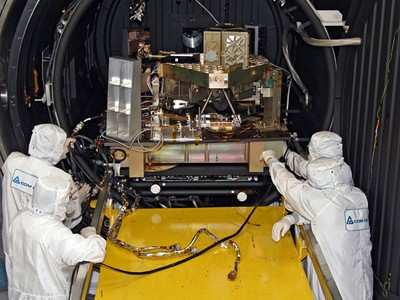Fri, Sep 10, 2010
"Fine Guidance Sensor", Other Instruments Being Built In
Ottawa
 The Canadian Space Agency has
delivered a test unit of its contribution to the James Webb Space
Telescope, successor of the Hubble Space Telescope, to NASA's
Goddard Space Flight Center in Maryland.
The Canadian Space Agency has
delivered a test unit of its contribution to the James Webb Space
Telescope, successor of the Hubble Space Telescope, to NASA's
Goddard Space Flight Center in Maryland.
Canada is providing Webb's Fine Guidance Sensor (FGS), as well
as one of the telescope's four science instruments called the
Tunable Filter Imager (TFI). Both are being built in Ottawa and
Cambridge, Ontario, by COM DEV International for the Canadian Space
Agency. The hardware was tested at the Canadian Space Agency's
David Florida Lab to ensure that the final version will function at
peak performance. While all space missions undergo extensive
testing, this step is particularly crucial for Webb: unlike Hubble,
Webb will be located 1.5 million km from Earth, and will be too far
to be serviced by astronauts.
The Fine Guidance Sensor consists of two specialized
cameras that are critical to Webb's ability to "see": they will
work like a guiding scope to allow the Webb space telescope to
locate its celestial targets, determine its own position and remain
pointed at an object so that the telescope can collect high-quality
data. The FGS will measure the position of guide stars with
incredible precision, pinpointing them with an accuracy of one
millionth of a degree (the angle formed by someone holding up a
quarter at a distance of 1500 km away—from Montreal to St
John's, Newfoundland). The TFI's unique capabilities will allow
astronomers to peer through clouds of dust to see stars forming and
planetary systems, possibly even exoplanets (planets outside our
Solar System). It also offers unique capability to find the
earliest objects in the Universe's history. The Canadian Project
Scientist for Webb is Dr John Hutchings of the National Research
Council Herzberg Institute of Astrophysics in Victoria, BC. Dr
René Doyon of the Université de Montréal is
the principal investigator for TFI. Canada is also providing
functional support of the science operations for the Webb space
telescope. The Canadian Space Agency will deliver the flight units
of the FGS and the TFI to NASA in 2011.

Webb Telescope Fine Guidance Sensor CSA Photo
The Webb space telescope is an international collaboration
between NASA, the European Space Agency and the Canadian Space
Agency. Scheduled for launch in 2014, Webb will be the first
next-generation large space observatory and will serve thousands of
astronomers worldwide for a planned lifetime of 10 years or more.
Designed to detect light from as far away as approximately 14
billion light years, it will study every phase in the history of
our Universe, ranging from the first luminous glows after the Big
Bang, to the formation of solar systems capable of supporting life
on planets like Earth, to the evolution of our own Solar System.
Its advanced technology also enables it to discover hitherto
unknown phenomena in the Universe.
More News
He Attempted To Restart The Engine Three Times. On The Third Restart Attempt, He Noticed That Flames Were Coming Out From The Right Wing Near The Fuel Cap Analysis: The pilot repor>[...]
Make Sure You NEVER Miss A New Story From Aero-News Network Do you ever feel like you never see posts from a certain person or page on Facebook or Instagram? Here’s how you c>[...]
From 2009 (YouTube Edition): Leading Air Show Performers Give Their Best Advice for Newcomers On December 6th through December 9th, the Paris Las Vegas Hotel hosted over 1,500 air >[...]
Aero Linx: NASA ASRS ASRS captures confidential reports, analyzes the resulting aviation safety data, and disseminates vital information to the aviation community. The ASRS is an i>[...]
“For our inaugural Pylon Racing Seminar in Roswell, we were thrilled to certify 60 pilots across our six closed-course pylon race classes. Not only did this year’s PRS >[...]
 NTSB Final Report: Rutan Long-EZ
NTSB Final Report: Rutan Long-EZ ANN FAQ: Turn On Post Notifications
ANN FAQ: Turn On Post Notifications Classic Aero-TV: ICAS Perspectives - Advice for New Air Show Performers
Classic Aero-TV: ICAS Perspectives - Advice for New Air Show Performers ANN's Daily Aero-Linx (06.28.25)
ANN's Daily Aero-Linx (06.28.25) Aero-News: Quote of the Day (06.28.25)
Aero-News: Quote of the Day (06.28.25)




